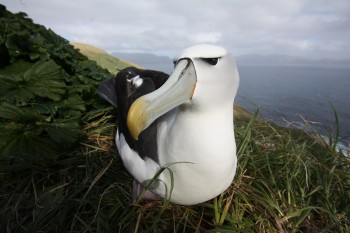John Parkes (Kurahaupo Consulting, Christchurch, New Zealand) and colleagues have published open-access in the New Zealand Journal of Ecology on the New Zealand Government’s plan to eradicate introduced mammalian predators on island nature reserves by 2025, identifying which islands should be targeted. Such action would include ridding Auckland Island of its House Mice Mus musculus, feral cats Felis catus and pigs Sus scrofa, thus eliminating their predation of seabirds, including ACAP-listed species, such as the Near Threatened White-capped Albatross Thalassarche steadi - a New Zealand endemic.
“In 2016, the New Zealand Government announced a policy to rid the country of key introduced predators (possums (Trichosurus vulpecula), ship rats (Rattus rattus), Norway rats (R. norvegicus) and mustelids (Mustela spp.)) by 2050. An interim goal under this policy is to remove all mammalian predators (the key species as well as mice (Mus musculus), kiore (R. exulans), cats (Felis catus), pigs (Sus scrofa) and hedgehogs (Erinaceus europaeus)) from island nature reserves by 2025. We identify the New Zealand islands over one hectare managed as reserves by the Department of Conservation (DOC) that have mammalian predators that can be eradicated. There are over 850 islands, islets, stacks and vegetated rocks in the New Zealand archipelago. We exclude islands in lakes and rivers and those smaller than one hectare, which leaves 616 islands, less than half of which are under some form of reserve status (286 islands entirely managed by DOC and 13 under mixed tenures but with some reserve land). One or more mammalian predators are known to occur on 48 of these islands, with the Government’s 2050 target species on 42 islands and other predators (in the absence of the target species) on six islands. The Government’s 2025 goal nominates one class of reserve, nature reserves. Of the 48 islands, just four islands are classed as nature reserves – two (Mauitaha and Araara Islands) with protected kiore in the Hen and Chickens group and two in the Auckland Islands group (Auckland with mice, cats and pigs; and Masked with mice and cats) – i.e. none with the key species of the wider 2050 goal. Therefore, we consider other reserve classes but place more or less strict risks of reinvasion, as indexed by known swimming ranges of the predators, to judge the feasibility of eradication. Relaxing the reserve class of the island, but not our selection of swimming ranges, results in 15 candidate islands where all mammalian predators present could be eradicated for the 2025 interim goal. Decisions on which islands to select for the programme need to consider costs and other constraints to eradicate different combinations of predators, and whether the island and its predators provide templates for the wider vision of a predator-free New Zealand, i.e. whether any of the key 2050 predators are present, the size of the island, and/or the presence of human inhabitants that complicate the predators to be targeted or constrain the use of some control methods.”
White-capped Albatross at the Auckland Islands, photograph by Graham Parker
Read a popular article on the paper here.
John P. Parkes, J.P., Byrom, A.E & Edge, K.A. 2017. Eradicating mammals on New Zealand island reserves: what is left to do? New Zealand Journal of Ecology 41. doi.org/10.20417/nzjecol.41.25.
John Cooper, ACAP Information Officer, 12 May 2017

 English
English  Français
Français  Español
Español